外研版高中英语必修五全册全英文教案
完整版外研版必修五Module5教案

- Write a short passage about your ideal life in the future.
- Describe your favorite film and explain why you like it.
2.答案:
八、课后反思及拓展延伸
1.反思:关注学生的学习反馈,总结教学过程中的优点和不足,不断调整教学策略。
四、教学过程的设计
教学过程应注重实践性和互动性。导入环节通过展示短片引发学生兴趣,实践情景引入环节则让学生运用所学知识进行讨论和表达。此外,例题讲解和随堂练习的设计要注重针对性和层次性,确保学生能够扎实掌握所学知识。
五、板书设计
板书是课堂教学的重要辅助手段,应简洁明了、重点突出。本节课的板书设计分为两部分,分别展示两个单元的主题和关键知识点。在板书过程中,教师应注重逻辑性和条理性,使学生能够直观地了解课堂内容。
2.拓展延伸:
-鼓励学生课后观看英语电影,提高听力水平,了解不同文化背景。
-组织课后小组活动,让学生以小组形式讨论未来生活及电影相关话题,提高学生的合作能力和口语表达能力。
重点和难点解析
1.教学内容的选取与组织
2.教学目标的设定
3.教学难点与重点的区分
4.教学过程的设计
5.板书设计
6.作业设计
一、教学内容的选取与组织
2.分析学生在课堂上的表现,了解学生的兴趣和需求,调整教学目标以更好地满足学生发展。
二、教学过程的有效性
1.反思课堂实践情景引入、例题讲解、随堂练习等环节的设计是否合理,能否有效提高学生的学习效果。
2.考虑如何增加课堂互动,激发学生的学习兴趣和参与度。
三、教学方法和策略的调整
高二英语外研版 必修5 Module 教案
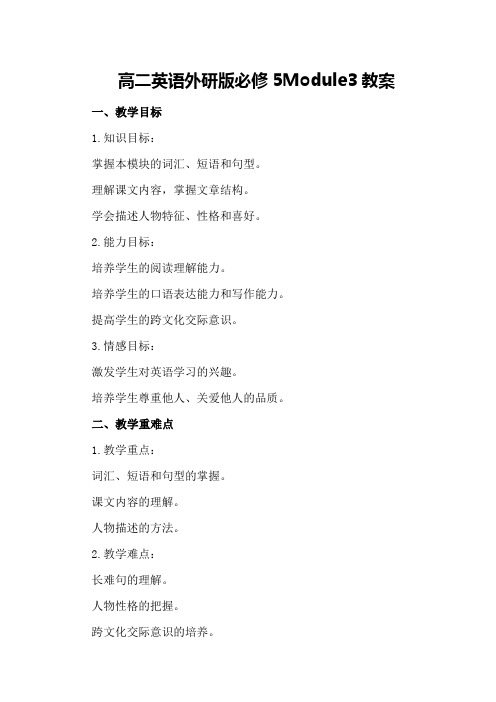
高二英语外研版必修5Module3教案一、教学目标1.知识目标:掌握本模块的词汇、短语和句型。
理解课文内容,掌握文章结构。
学会描述人物特征、性格和喜好。
2.能力目标:培养学生的阅读理解能力。
培养学生的口语表达能力和写作能力。
提高学生的跨文化交际意识。
3.情感目标:激发学生对英语学习的兴趣。
培养学生尊重他人、关爱他人的品质。
二、教学重难点1.教学重点:词汇、短语和句型的掌握。
课文内容的理解。
人物描述的方法。
2.教学难点:长难句的理解。
人物性格的把握。
跨文化交际意识的培养。
三、教学过程1.导入利用图片、视频或故事导入本模块的主题。
提问:你们对这个人有什么印象?他的性格特点是什么?2.词汇教学利用图片、实物或情境教授新词汇。
设计一些练习,让学生在语境中运用新词汇。
3.阅读教学让学生快速阅读课文,了解文章大意。
分析课文结构,找出文章的主题句。
对课文中的长难句进行讲解,帮助学生理解。
设计问题,让学生回答,检查他们对课文的理解。
4.口语教学设计一些角色扮演、讨论或采访活动,让学生在语境中运用所学知识。
教师示范,引导学生模仿。
5.写作教学提供一些写作素材,让学生进行写作练习。
分析优秀范文,让学生了解写作技巧。
批改学生作文,给出修改意见。
6.语法教学分析课文中的语法现象,让学生了解语法规则。
设计一些练习,让学生在语境中运用语法知识。
7.跨文化交际教学分析课文中的跨文化交际现象,让学生了解不同文化背景下的交际方式。
设计一些实践活动,让学生在模拟情境中运用跨文化交际知识。
8.课堂小结对学生的表现给予肯定和鼓励。
四、作业布置1.复习本节课的词汇、短语和句型。
2.完成课文后的练习。
3.准备下一次课的口语活动。
五、教学反思本节课通过多种教学活动,让学生在语境中学习英语,提高了他们的阅读理解能力、口语表达能力和写作能力。
但在教学过程中,仍有一些不足之处,如:1.部分学生对长难句的理解仍有困难,需要加强语法教学。
2.部分学生的口语表达能力较弱,需要加强口语练习。
外研版高中英语第五册(必修5)

外研版高中英语第五册(必修5)教案设计(B)Module 6 Animals in DangerBy No. 21 High School Zhang Nan课时一阅读(Introduction & Reading)教学分析本模块以Animals in Danger为话题,使学生了解一些濒临灭绝的动物及它们的现状,培养学生保护动物的意识,并使学生掌握一些动物名称及相关的词汇。
Introduction部分复习和学习一些与野生动物有关的词汇,学会简要分析珍稀动物濒临灭绝的主要原因。
Reading 部分介绍了藏羚羊濒临灭绝的现状和原因,以及我国政府和世界自然保护组织为拯救藏羚羊所做的努力。
学生除了学习新词汇、训练阅读技巧外,对动物保护有了更深刻的认识。
教案内容教学目标1.语言目标1)重点词汇及短语1. reserve, habitat, endangered, extinct, wildlife, protect, in danger, thanks to2. poacher, antelope, battle, plateau, ideal, shawl, herd, worth, skin, spot, raid, confiscate,condition, meanwhile, dealergive one’s life to, at a time, be worth so much, on the spot, be made into, come intofashion, take an active part in doing, be ready for, get tough with2)重点句式1. Thanks to scientists’hard work, the number of the pandas living in the wild hasincreased to about 1590.2. Although surprised, the poachers had an advantage --- there were more of them.3. A shawl made from the wool (known as “shahtoosh”, or “king of wools” in Persian)can sell for five thousand dollars.4. Often working at night, the poachers shoot whole herds of antelopes at a time, leavingonly the babies, whose wool is not worth so much.5. But today the government seems to be winning the battle.2. 能力目标1. Learn some information about the present situation of the wild animals and the effortmade to protect the wild animals.2. Enable students to use some key words and some expressions correctly.3. Get students to catch the main information about numbers.4. Learn to predict before reading.5. Discuss the questions about the passage.3.教学重难点1. Guide students to summarize the main idea of each paragraph as well as the main idea ofthe text.2. Discuss the questions of comprehension.3. Get students to learn about the importance of protecting animals.4.教学方法1. Fast reading skills for main ideas and details.2. Discussions to improve students reading comprehension of the passage.3. Individual, pair or group work to make every student work in class.教学过程Step 1 Lead-in: Show different pictures of tigers to arouse the students’ interest, and then get the students to talk about tigers and do Activity 1.Step 2 Vocabulary: Learn some important words about animal’s protection and do Activity2.Step 3 Discussion: Work in groups and discuss the reasons why some animals are becomingextinct.Step 4 Prediction: Get the students to look at the picture on the top and guess what thepassage is about.1. What is this species of animals in the picture?2. Where is this happening?3. What are these people in the picture?4. What is the passage about?Step 5 Main ideasThe general idea of the text: The reading gives a brief description of the currentsituation of antelopes. Realize the importance and urgency of protecting the wildanimals. The struggle of protecting antelopes will last a long time and will call onmore and more people to take part in it.Paragraph 1: Jiesang Suonandajie gave his life to save the Tibetan antelope.Paragraph 2: A large number of antelopes have been killed for their wool.Paragraph 3: The business of antelope wool is illegal but it is not easy to be stopped.Paragraph 4: The Chinese government began to take an active part in protecting theantelopes.Paragraph 5: Progress has been made in protecting the antelopes.Step 6 Scanning: Get the students to read the passage carefully to do Activities 2, 3 and 4.Step 7 While-reading: Read the text carefully and fill in the blanks with the information inStep 8 Post-reading: discussion1. What do we learn from the text?2. Why do we have to prevent the animals from dying out?3. What can we do to help the animals?Step 9HomeworkWorkbook on P 98 Ex. 4 and 5.课后反思:珍稀动物濒临灭绝是学生比较感兴趣的话题。
外研版高中英语必修五教案:Module 1 The Third Period Grammar

The Third Period GrammarTeaching goals教学目标1. Target language目标语言Learn the grammar —verb forms: present simple, present continuous, present perfect and future reference; for and since with present perfect2. Ability goals能力目标Enable the students to use the verb forms freely.3. Learning ability goals学能目标Help the students learn how to use verb forms freely.Teaching important points教学重点The differences between present simple and present continuous.Teaching difficult points教学难点How to use present perfect properly.Teaching methods教学方法Explaining and practising.Teaching aids教具准备A projector and a computer.Teaching procedures & ways教学过程与方式Step I RevisionAsk the students to pick out the verb forms used in the text. Then sum up the following verb forms: present simple, present continuous, present perfect and future reference; for and since with present perfect.Step II GrammarDeal with Exercise 1 on page 4. From this exercise, the students will have a better understanding of the meaning of each verb form.Show the following on the PowerPoint.Meaning of each verb form:Present SimpleHabitual or repeated actionScientific fact / thing generally accepted as truePresent ContinuousAction in progress at this momentAction in progress through a period of time including the presentPresent PerfectPast action or state which is connected to the present in some wayFuture ReferencePredictions and expectations“Be going to” is usually used to talk about an intention or plan. It is usually used to make a prediction about immediate future.for and since with Present PerfectUse the present perfect with for, since to talk about actions and states that began in the past and continue to the present. These time expressions of duration tell how long the action or state has been lasting. For tells the length of time. (For can sometimes be omitted.) Since tells the beginning of the time period.Step III PracticeDeal with the grammar Exercise 2 on page 4. Let the students do the exercise individually first, then they will discuss why they choose the verb form. Check the answers with the whole class.Deal with the grammar Exercises 3-4 on page 5 in the same way.Step IV DiscussionFor Exercise 5, divide the students into different groups and discuss the future of English. Then complete the sentence in Exercise 5. Ask the students to make use of future reference.Sample sentences:In the future, English is going to be spoken by more and more people.In the future, English is going to be one of the official languages in China.In the future, English speakers of different varieties won’t find it difficult to understand each other.Step V Practice (WORKBOOK)Deal with the grammar exercises in WORKBOOK. The students are encouraged to tellthe reasons why they choose the verb form.If time is enough, deal with Exercise 2 as a game.In order to stimulate the students’interest, deal with Exercise 2 as a game. Make multiple copies of this exercise or add more sentences.(Teacher may also ask the students to write sentences or pick from the text and cut them and then distribute them to their classmates.) Cut the exercise into pieces, divide the students into pairs or groups, and give each pair / group a complete set of all the sentences to match. Distribute one card per student. The students should walk around the room and find the answer to their sentences. Combinations must be grammatically correct and logical. Remind the students that they should pay attention to punctuation. Once they have found their matches, ask each pair to read their sentence and identify both the timeframe and the tense(s) used. If necessary, emphasize any tricky grammar structures.Step VI HomeworkGo over the grammar points in this module.Sum up the phrases used to give advice.。
外研版高中英语第五册(必修5)(精)
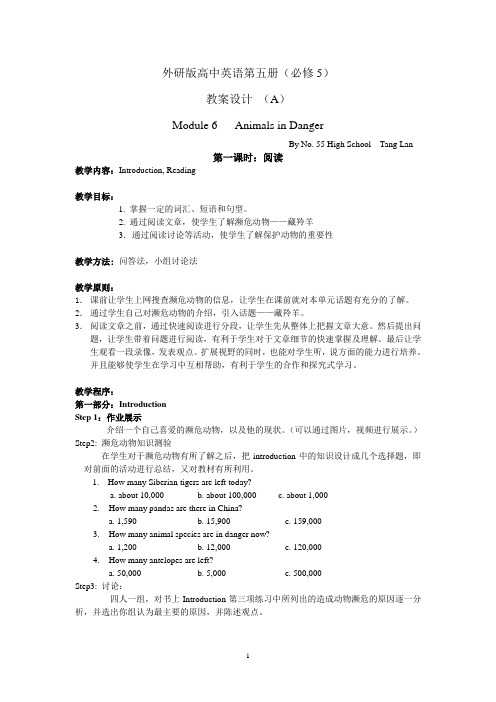
外研版高中英语第五册(必修5)教案设计(A)Module 6 Animals in DangerBy No. 55 High School Tang Lan第一课时:阅读教学内容:Introduction, Reading教学目标:1. 掌握一定的词汇、短语和句型。
2. 通过阅读文章,使学生了解濒危动物——藏羚羊3.通过阅读讨论等活动,使学生了解保护动物的重要性教学方法: 问答法,小组讨论法教学原则:1.课前让学生上网搜查濒危动物的信息,让学生在课前就对本单元话题有充分的了解。
2.通过学生自己对濒危动物的介绍,引入话题——藏羚羊。
3.阅读文章之前,通过快速阅读进行分段,让学生先从整体上把握文章大意。
然后提出问题,让学生带着问题进行阅读,有利于学生对于文章细节的快速掌握及理解。
最后让学生观看一段录像,发表观点。
扩展视野的同时,也能对学生听,说方面的能力进行培养。
并且能够使学生在学习中互相帮助,有利于学生的合作和探究式学习。
教学程序:第一部分:IntroductionStep 1:作业展示介绍一个自己喜爱的濒危动物,以及他的现状。
(可以通过图片,视频进行展示。
)Step2: 濒危动物知识测验在学生对于濒危动物有所了解之后,把introduction中的知识设计成几个选择题,即对前面的活动进行总结,又对教材有所利用。
1. How many Siberian tigers are left today?a. about 10,000b. about 100,000c. about 1,0002.How many pandas are there in China?a. 1,590b. 15,900c. 159,0003.How many animal species are in danger now?a. 1,200b. 12,000c. 120,0004.How many antelopes are left?a. 50,000b. 5,000c. 500,000Step3: 讨论:四人一组,对书上Introduction第三项练习中所列出的造成动物濒危的原因逐一分析,并选出你组认为最主要的原因,并陈述观点。
2024年外研版高中英语必修五全册全英文教案
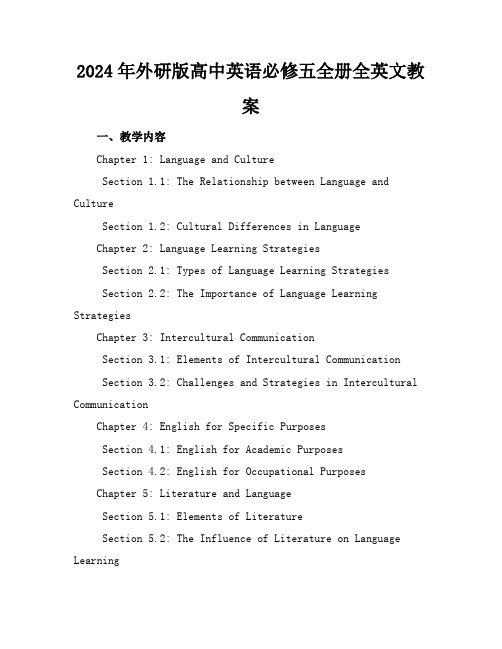
2024年外研版高中英语必修五全册全英文教案一、教学内容Chapter 1: Language and CultureSection 1.1: The Relationship between Language and CultureSection 1.2: Cultural Differences in LanguageChapter 2: Language Learning StrategiesSection 2.1: Types of Language Learning StrategiesSection 2.2: The Importance of Language Learning StrategiesChapter 3: Intercultural CommunicationSection 3.1: Elements of Intercultural CommunicationSection 3.2: Challenges and Strategies in Intercultural CommunicationChapter 4: English for Specific PurposesSection 4.1: English for Academic PurposesSection 4.2: English for Occupational PurposesChapter 5: Literature and LanguageSection 5.1: Elements of LiteratureSection 5.2: The Influence of Literature on Language Learning二、教学目标1. Enable students to understand the relationship between language and culture, and apply this understanding inreallife situations.2. Equip students with various language learning strategies and help them develop autonomous learning abilities.三、教学难点与重点Teaching difficulties and key points include:1. The abstract concepts of language and culture, and their interrelationship.2. The effective application of language learning strategies in different learning scenarios.四、教具与学具准备Teaching aids and learning materials needed:1. Textbooks: 2024 edition of the Senior High School English curriculum (Volume 5).3. Handouts with additional exercises and activities for inclass practice.4. Whiteboard and markers for the teacher to illustrate key points.五、教学过程1. Introduction (10 minutes):Engage students in a practical scenario where they encounter cultural differences in language use.Encourage students to share their experiences and observations.2. Presentation (20 minutes):Present the main concepts of each chapter usingvisual aids and reallife examples.Provide clear explanations and definitions of key terms and ideas.3. Practice (15 minutes):Offer immediate feedback and guidance to ensure understanding.4. Example Explanation (15 minutes):Present a sample problem related to the chapter content.Walk through the problemsolving process step step, highlighting the application of learned strategies.5. Group Work (15 minutes):Divide students into groups to discuss and present on a specific aspect of the chapter.Encourage active participation and peer learning.六、板书设计The board design will include:1. The of each chapter and section.2. Key concepts, terms, and definitions.3. A visual representation of the relationship between language and culture.七、作业设计Homework will consist of the following exercises:1. Comprehension questions based on the chapter content.Answer: To be provided after the students submittheir work.2. A written reflection on a personal experienceinvolving language and culture.Answer: Openended, but guidance on structure and content will be provided.八、课后反思及拓展延伸Postclass reflection and extension activities:1. Evaluate the effectiveness of the teaching methods and adjust accordingly for future lessons.3. Encourage students to apply their knowledge inreallife situations, such as participating in language exchange programs or cultural events.重点和难点解析1. 教学难点与重点的确定2. 教具与学具的准备3. 教学过程中的实践情景引入4. 例题讲解的步骤5. 板书设计6. 作业设计一、教学难点与重点的确定针对语言与文化关系的抽象概念,需要通过具体的实例和互动讨论来帮助学生理解。
外研版高中英语必修五教案:Module 5 The Fourth Period Listening
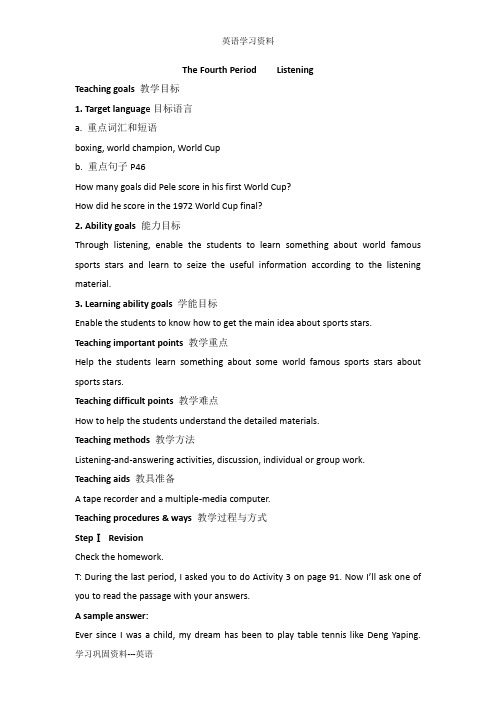
The Fourth Period ListeningTeaching goals教学目标1. Target languag e目标语言a. 重点词汇和短语boxing, world champion, World Cupb. 重点句子P46How many goals did Pele score in his first World Cup?How did he score in the 1972 World Cup final?2. Ability goals能力目标Through listening, enable the students to learn something about world famous sports stars and learn to seize the useful information according to the listening material.3. Learning ability goals学能目标Enable the students to know how to get the main idea about sports stars. Teaching important points教学重点Help the students learn something about some world famous sports stars about sports stars.Teaching difficult points 教学难点How to help the students understand the detailed materials.Teaching methods教学方法Listening-and-answering activities, discussion, individual or group work.Teaching aids教具准备A tape recorder and a multiple-media computer.Teaching procedures & ways教学过程与方式StepⅠRevisionCheck the homework.T: During the last period, I asked you to do Activity 3 on page 91. Now I’ll ask one of you to read the passage with your answers.A sample answer:Ever since I was a child, my dream has been to play table tennis like Deng Yaping.However, I had no opportunity to go to a sporting school. So I have not enough time to practice until recently I was chosen as a team member by our school team. Now I spend several hours on practicing it every week. Whatever difficulties I meet, I will try my best to overcome them and improve my skill.Step ⅡWarning up and Lead-inShow some pictures of sports stars home and abroad on the screen.T: Look at the screen please. Who are they?Ss: Deng Yaping, Yao Ming, Jordan and Liu Xiang.T: They are all sport stars. Do you know any other sports stars?Ss: Sun Jihai, Xing Luna ...T: Then do you know what they do? Please make a chart like the one on the screen.Let the students work in groups of six. A few minutes later, check their answers.T: What else do you know about them?S1: I’d like to say something about Liu Xiang. He was born on July 13th, 1983. He comes from Shanghai. He is 1. 88 metres tall and 74 kilograms. In the last Olympic games, he got a gold medal in 110-metre hurdle. It was the first time that our country won a gold medal in such an event.Ss: ...T: Great! You know so much about these sports stars. But we should know it is not easy to become a sports star. He or she must have an iron will and decent spirit. He or she must face many difficulties and challenges, including serious injury. He or shemust know he or she is working for his / her motherland.Step ⅢListeningT: OK! Now let’s open the textbook and turn to page 46. Look at the three pictures. Can you name each sport?Ss: Yes. The sport in picture 1 is boxing. The one in picture 2 is running race and the last one is football game.T: Who is the sportsman in each picture?Ss: The first one is Ali, the second one is Kip Keino and the last one is Pele.T: Can you tell me more about them?S1: I will have a try. Ali was recognized as the world’s greatest sportsperson ever when he was granted award of “Sports Personality of the Millennium”by BBC people’s choice award at the end of the millennium.T: Who can tell something about the other two people?S2: I just know Kip Keino is famous for running and he won many medals in Olympic Games. Pele, a South American superstar, who was the world’s most famous and highest-paid athlete when he joined a North American team in 1975. He led the Brazilian national soccer team to win three World Cup victories in 1958, 1962 and 1970. In 1980, he was named athlete of the century.T: Good! Let’s listen to part 1 first and tick what people listening to the program have to do.Give the students several seconds to scan the requirement and make sure they know what they should do. Then play the tape for the students and finish Activity 2. After that check the answers with the whole class.T: Just now, some students gave a brief introduction about Ali, Kip Keino and Pele. Do you want to know more about them?Ss: Yes.T: Then let’s listen to Part 2 of the conversation.Go through the requirement of Activity 3 with the students. Play the tape twice. For the first time, students just listen. For the second time, students should answer the questions. Pause the tape if necessary. Finally, check the answers with the wholeclass.T: Let’s listen to Part 2 again and finish Activities 4 and 5.Play the tape again and let the students discuss the questions in pairs. Then check the answers.Step IV Listening Practice1. Pre-listeningAsk the students to finish Activity 12 of WORKBOOK on page 94.T: Look at Activity 12 on page 94. You can use the words in the boxes to help you. For example, I don’t think girls could do boxing because they might get hurt. Now discuss with your partner and write down as many sentences as possible. Then I will ask some of you to read your sentences.A few minutes later, ask several students to read their sentences.T: Well, who would like to read your sentence first?S1: I don’t think boys and girls in China can play golf because it will cost them too much money.S2: In my opinion, girls had better not go mountain climbing because it is dangerous for them.S3: I believe boys enjoy playing football because they think playing football is exciting....2. ListeningT: Now we are going to listen to a passage about sports. You will listen to it three times. When I play the tape for the first time, just listen without making notes. The second time I play the tape, try to write down the answers. The last time I play the tape, check your answers.Then check the answers with the whole class.Step V Summary and HomeworkT: Today we have reviewed some sports names and known some world stars. After class please collect some information about your favorite sports star. You can go to the library or surf the Internet. Then preview CULTURAL CORNER.。
2024年完整版外研版必修五Module5教案
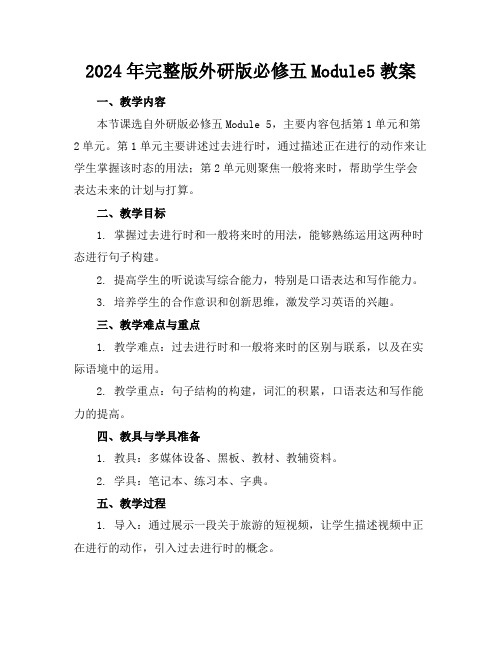
2024年完整版外研版必修五Module5教案一、教学内容本节课选自外研版必修五Module 5,主要内容包括第1单元和第2单元。
第1单元主要讲述过去进行时,通过描述正在进行的动作来让学生掌握该时态的用法;第2单元则聚焦一般将来时,帮助学生学会表达未来的计划与打算。
二、教学目标1. 掌握过去进行时和一般将来时的用法,能够熟练运用这两种时态进行句子构建。
2. 提高学生的听说读写综合能力,特别是口语表达和写作能力。
3. 培养学生的合作意识和创新思维,激发学习英语的兴趣。
三、教学难点与重点1. 教学难点:过去进行时和一般将来时的区别与联系,以及在实际语境中的运用。
2. 教学重点:句子结构的构建,词汇的积累,口语表达和写作能力的提高。
四、教具与学具准备1. 教具:多媒体设备、黑板、教材、教辅资料。
2. 学具:笔记本、练习本、字典。
五、教学过程1. 导入:通过展示一段关于旅游的短视频,让学生描述视频中正在进行的动作,引入过去进行时的概念。
2. 新课内容呈现:讲解过去进行时和一般将来时的用法,结合教材例句进行分析。
3. 实践情景引入:分组进行角色扮演,让学生在实际语境中运用所学时态进行口语表达。
4. 例题讲解:针对过去进行时和一般将来时设置相关题目,引导学生进行思考和分析。
5. 随堂练习:让学生进行句子仿写,巩固所学时态。
6. 小组讨论:讨论一般将来时在实际生活中的应用,培养学生的创新思维。
六、板书设计1. Module 5 Past Continuous and Future Simple2. 内容:过去进行时:结构、用法、例句一般将来时:结构、用法、例句词汇积累:与旅游相关的词汇七、作业设计1. 作业题目:根据所给关键词,用过去进行时和一般将来时编写一段关于旅行的对话。
以“我的未来计划”为题,用一般将来时写一篇短文。
2. 答案:对话示例:A: What were you doing yesterday? B: I was packing for my trip to Beijing. I will leave tomorrow.短文示例:My future plan is to travel around the world. I will start with Europe and then go to America.八、课后反思及拓展延伸1. 反思:本节课通过实践情景引入、例题讲解、随堂练习等多种教学手段,让学生掌握了过去进行时和一般将来时的用法。
- 1、下载文档前请自行甄别文档内容的完整性,平台不提供额外的编辑、内容补充、找答案等附加服务。
- 2、"仅部分预览"的文档,不可在线预览部分如存在完整性等问题,可反馈申请退款(可完整预览的文档不适用该条件!)。
- 3、如文档侵犯您的权益,请联系客服反馈,我们会尽快为您处理(人工客服工作时间:9:00-18:30)。
外研版高中英语必修五全册全英文教案Module 1 British and American EnglishPeriod 1Introduction& Reading and speaking Teaching Aim:Help the students to know some differences between British English and American English.Teaching Important Point:Help the students to know some differences between British English and American English.Teaching Difficult Point:How to improve their speaking ability.Teaching Aid:the blackboardTeaching Procedures:Step1. Read the quotations and answer the questions:1) What is the topic of the quotations?2) Whose opinion is the most optimistic?3) Whose opinion is the most pessimistic?Step2. Read the emails and say what the writers have in common.Step3. Check the true statements1) People from Hong Kong can understand people from Beijing.( Open)2) People from Shanghai sound the same as people from Xi’an.(Not true)3) Chinese characters can be understood by all speakers of Chinese.(True)4) American English is very different from British English.(Not true)5) People from Britain can’t understand people from America.( Not true)Period 2 Reading& Language points Teaching Aim:Help the students to understand the text and some language points. Teaching Important Point:Improve the students’ reading ability.Teaching Difficult Point:How to improve their reading ability.Teaching Aid:the blackboardTeaching Procedures:Step 1. ReadingRead the passage and find out ways in which British and American English are different.Step 2. Complete the sentences with the correct words or phrases.Step 3. Language points1、get around: 四处走动,到处旅游eg. She gets around with the help of a stick.2、differ from: 不同于…differ in: 在…方面不同3、be similar to: 与…相似4、have difficulty (in) doing sth. 做某事有困难have difficulty with sth.5、at the flick of a switch:开关一开6、suggest:1).表示“表明,暗示”时,后面宾语从句用陈述句语气。
Eg. When I suggested that some villagers must have come in for a free drink, Mr Thompson shook his head.All the evidence suggests that he stole the money.2).表示“建议”a. +doingEg. I suggested going out for a walk.b. +从句(从句使用虚拟语气,即should+do, 其中should可以省略)Eg. He suggested that we (should) have a meeting to discuss the problem.Period 3 Vocabulary& GrammarTeaching Aim:Review of verb formsTeaching Important Point:Present simple, present continuous, present perfect and future reference. Teaching Difficult Point:How to use for and since.Teaching Aid:The blackboardTeaching Procedures:Step1 Vocabulary1. Match the British and American words and phrases in the box.2. Rewrite the sentences using British words.1) We like going on holiday in the autumn very much.2) You don’t need to use the lift. Our flat is on the ground floor.3) Did you see that lorry come out of the petrol station?4) Pass me a torch, Eddie. I’ve lost my wallet.Step2 Grammar.(参阅课本109页)1. Some explanations about the Present Simple Tense, the Present ContinuousTense, the Present Perfect Tense.2. Complete the sentences with the correct form of the verbs.3. Complete the sentence with since or for.4. Complete the sentences with the correct verb form.Period 4 Vocabulary and ListeningTeaching Aim:Help the students to improve their listening ability.Teaching Important Point:Improve the students’ listening ability.Teaching Difficult Point:How to improve their listening ability.Teaching Aid:the blackboardtape recorderTeaching Procedures:1. Think about problems exchange Students have. Number them in order of importance.2. Complete the passage with the words in the box.3. Listen to the interviews and answer the questions.4. Listen again and answer the questions.Period 5 Everyday English& Function Teaching Aim:Learn some new sentences and learn to give reasons.Teaching Important Point:Learn to use because, since, as or now that.Teaching Difficult Point:How to give reasons.Teaching Aid:the blackboardTeaching Procedures:Step1. Everyday English.Complete the sentences with the correct phrases.Step2. Function.1. The differences between because, since, as and for.难点——because , since , as , for,辨析because, as, for, since这几个词都是表示"原因"的连词,语气由强至弱依次为:because→since→as→for;其中because, since, as均为从属连词,引导原因状语从句;而for 是并列连词,引导并列句。
1. because表示直接原因,它所指的原因通常是听话人所不知道的,其语气最强。
常用来回答why的提问,一般放于主句之后,也可以单独存在。
例如:She didn't go to work today because she is ill. 她今天没有去上班,因为她病了。
此外,在强调句型中,只能用because。
例如:It was because I missed the early bus that I was late for school. 我上学迟到是因为我没有赶上早班汽车。
2. since侧重主句,从句表示显然的或已为人所知的理由,常译为"因为"、"既然",语气比because稍弱,通常置于句首,表示一种含有勉强语气的原因。
